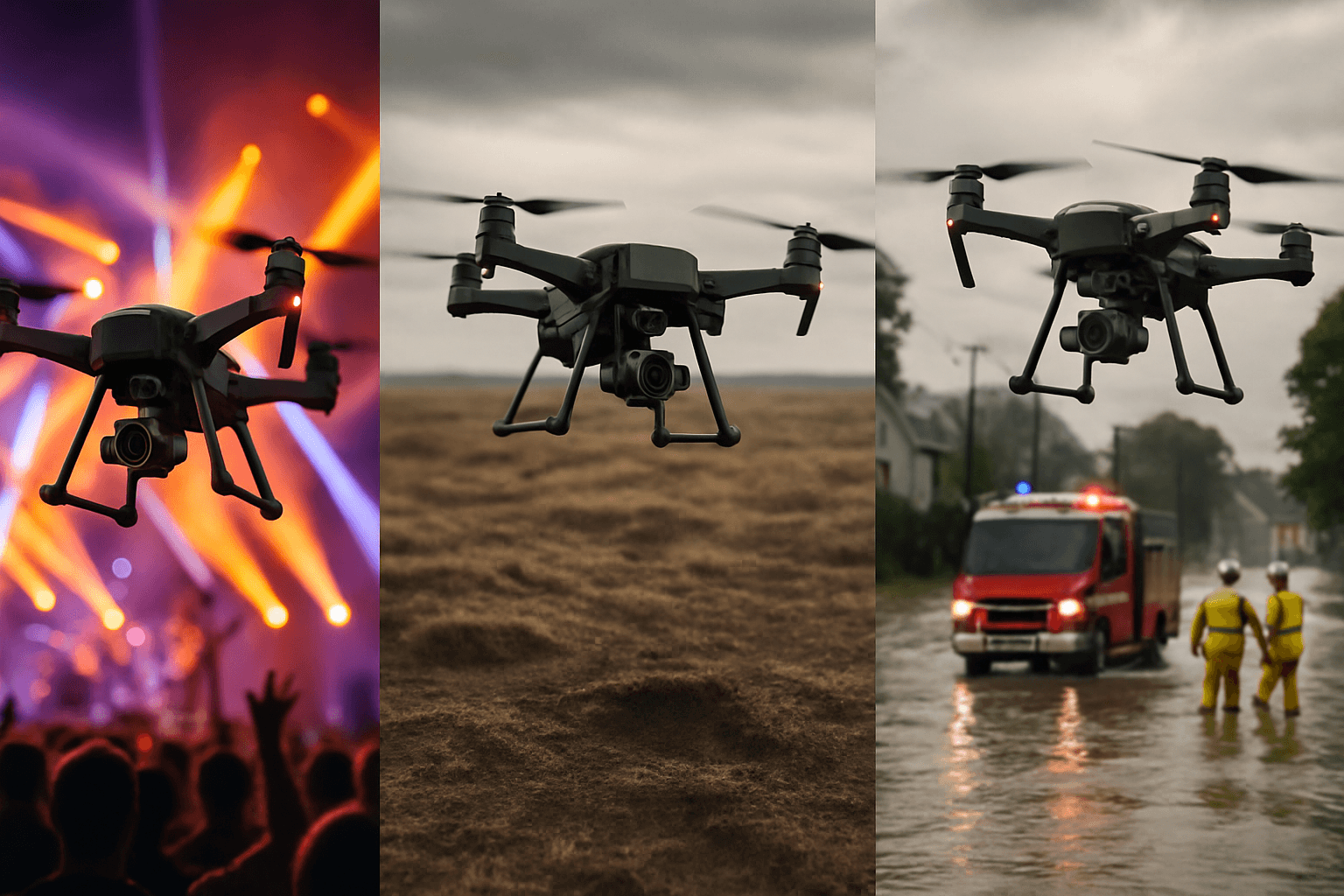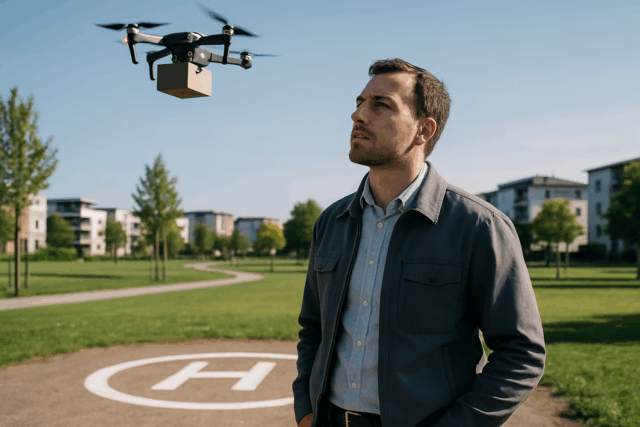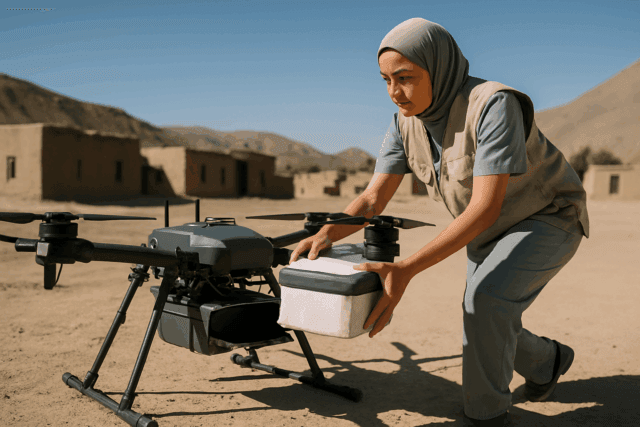The commercial drone industry continues to expand its reach, demonstrating innovative applications across diverse sectors. From enhancing entertainment spectacles to performing critical humanitarian work, drones are proving their versatility and impact. This week, we spotlight three compelling stories: drone integration at Eurovision 2025, UAVs neutralizing landmines, and the utilization of drones in disaster relief efforts in North Carolina.
Eurovision 2025 Lights Up with Drone Magic
The Eurovision Song Contest, known for its dazzling visual productions, has enlisted Verity Studios as an official technical supplier for its 2025 event in Basel, Switzerland. Verity Studios will deploy its Lucie micro drones, equipped with the new Mini Beam payload, to enhance the visual experience.
Mini Beams and Micro Drones
The Mini Beam payload introduces moving beam lights that operate without fixed mounting points, offering lighting designers unprecedented flexibility in positioning and moving beams in the air. The Lucie drones, weighing only 56 grams (2 ounces) and capable of flying for up to five minutes, are designed for consistent use in live, safety-critical environments. Verity is known for creative innovation, technical reliability, and Swiss precision. The selection of Verity is a testament to the reliability of its autonomous drone technology.
Regulations for Drones in Basel
During the show week (May 10-18, 2025), the use of private drones over the city of Basel is completely prohibited. Swiss security authorities will actively monitor drone activity and unauthorized drones will be intercepted or taken down if necessary. Violators will face fines or legal action. Visiting media teams will not be granted drone permits.
Neutralizing Landmines with UAVs: A Partnership for Safety
Draganfly Inc. and Autonome Labs have partnered to develop an integrated aerial deployment solution for M.A.G.I.C. (Mine and Ground Inert Clearance), Autonome’s groundbreaking mesh-based demining system.
M.A.G.I.C. Demining System
The collaboration will pair Draganfly’s Heavy Lift drone platform with Autonome’s M.A.G.I.C. system to safely and efficiently deploy demining mesh designed to detonate and neutralize landmines across hazardous terrain. The effort aims to enable rapid clearance of explosive threats, significantly reducing risk to human demining teams and accelerating the restoration of safe, usable land. The integrated system addresses the critical challenge of safety in demining operations, as landmines continue to pose a threat in post-conflict areas, hindering access to land for farming, development, and community use.
How it Works
Draganfly’s Heavy Lift platform will deploy Autonome’s M.A.G.I.C. mesh, designed to detect, neutralize, and detonate landmines. The drone will be adapted to fly at low altitudes and release the mesh with high precision. Autonome Labs brings expertise in building autonomous systems for use in extreme conditions. The collaboration enables a safer, more scalable solution for clearing dangerous terrain, protecting lives, and restoring access to vital land. Field testing is planned for 2025.
Other UAV Demining Solutions
- Mistral Hound: Mistral Hound uses rugged drones for mapping, detection, and detonation of landmines. It consists of a mapping drone and a detection-cum-detonation drone. The drones survey and map the area, detect landmines, pinpoint their location on a 3D map, and neutralize them either by detonating from air or defusing manually.
- ALDND: The Autonomous Landmine Detection and Neutralization Drone (ALDND) project aims to design a robust, autonomous drone capable of efficiently detecting and neutralizing landmines, reducing human risk and increasing demining efficiency. The drone will be equipped with ground-penetrating radar and AI systems for mine detection. Once a mine is detected, the drone will deploy a dispensing system to safely neutralize it using an environmentally friendly substance.
- UAB Unmanned Dynamics: UAB Unmanned Dynamics’ solution employs drone swarms equipped with various sensors to map mined areas. The data is analyzed using AI algorithms to detect mines. Anti-tank mines are neutralized by a Turtlebot Unmanned Ground Vehicle, while anti-personnel mines are dealt with using a modified road roller Unmanned Ground Vehicle.
Drones Aid Disaster Relief in North Carolina After Hurricane Helene
Following Hurricane Helene in September 2024, DJI drones and systems helped police in Asheville, North Carolina, with disaster relief efforts. The Asheville Police Department deployed 13 DJI Docks (a mix of DJI Dock, DJI Dock 2, and DJI Dock 3) across the city, creating a network that transformed their ability to assess, respond, and recover. The DJI drone-in-a-box systems enabled automatic, repeatable drone workflows, even in remote or challenging environments, empowering responders to reach impacted areas faster, safer, and more effectively. After the storm, DJI systems helped local authorities map thousands of acres of flood-damaged areas, pinpoint vulnerabilities in critical infrastructure, and deliver vital intelligence to state and local authorities.
Shamrock+ and Hurricane Helene Recovery
Shamrock+ deployed a team of FAA-certified drone pilots to western North Carolina to assist with ongoing Hurricane Helene recovery efforts. The team worked with JBW Federal and the U.S. Army Corps of Engineers to survey debris in streams and waterways affected by the storm. Shamrock+’s drone team began their work on February 6th, 2025, capturing aerial footage to assess the extent of the damage. The storm brought catastrophic rainfall, powerful winds, and tornadoes, leading to record-breaking flood events across multiple counties. Officials estimated that 50 million cubic yards of debris needed to be recycled or transported to landfills.
Lessons Learned from Hurricane Helene
- Reliable connectivity: Ensuring UAV teams have satellite communication options like Starlink to maintain real-time data transfer.
- Proactive coordination: Establishing clear agreements with industry partners and volunteer groups ahead of time to streamline disaster response.
- Cross-agency budgeting: Exploring creative funding solutions that allow police, fire departments, city departments, and emergency management teams to share drone program resources.
- Advanced UAV training: Expanding UAV operator training in disaster response scenarios, particularly in search and rescue operations.
The Future of Drones in Emergency Management
With continued investment in UAV technology and operational planning, future disaster response efforts can be even more effective, ensuring that communities receive faster, better-coordinated relief in the wake of major storms.





